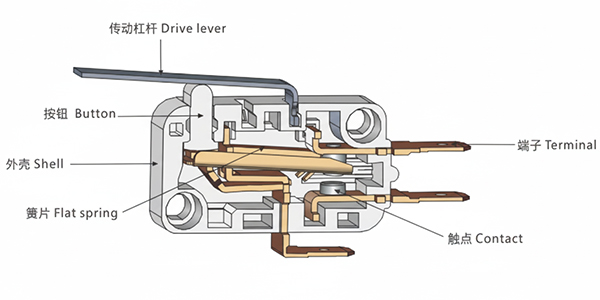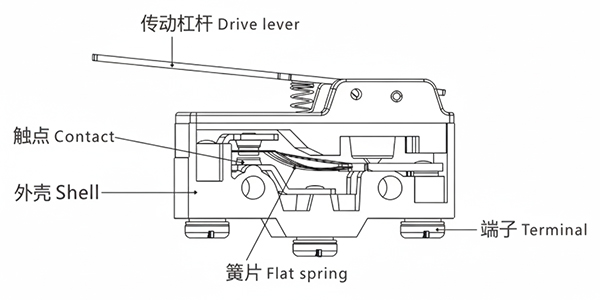The global energy structure is undergoing a profound transformation, with photovoltaic (PV) power generation and large-scale energy storage systems (ESS) driving a full transition towards high-voltage and high-density solutions. As system energy capacity and voltage levels continuously rise, ensuring the safety of equipment and maintenance personnel while maximizing operational efficiency has become a critical industry challenge. Addressing this requires looking beyond software and cloud-based control, returning to the most fundamental and reliable physical interlocking mechanisms. The microswitch (or miniature snap action switch) is the ultimate expression of this safety philosophy. It reliably converts physical actions—such as personnel operation, mechanical component status, and environmental protection conditions—into electrical signals. In new energy systems, the microswitch acts as a “safety anchor,” constructing hardware-level mandatory interlocking to provide an unshakeable physical foundation for high system reliability and operational safety.

The Role of the Microswitch in New Energy Safety
The core value of the micro switch lies in achieving a seamless, reliable conversion from “mechanical action to electrical signal,” acting as the physical “anchor point” for the control logic in high-voltage new energy systems. In high-current, high-voltage environments, while system control logic is driven by sophisticated software and digital communication networks, these electronic signals are vulnerable to electromagnetic interference (EMI), communication delays, or programming errors. The presence of the microswitch provides an immediate and definitive physical feedback mechanism that transcends digital logic. It converts the mechanical “at-position” status of breakers, doors, or interlocking mechanisms directly into clear ON/OFF electrical signals, ensuring the foundation of safe operation rests upon undeniable physical reality, making it a safety cornerstone that software control systems must rely on and respect.
1. Microswitch for Constructing Mandatory Hardware Interlocking
In complex control environments, programmatic code and sensor signals can be susceptible to EMI or software glitches. In contrast, the micro switch provides a mandatory, non-bypassable hardware interlocking mechanism. Its operational principle is simple: the switch contacts will only close or open when the device or operation fulfills a preset mechanical condition, thereby permitting (or prohibiting) subsequent high-voltage operations. This mechanism hardwires the core safety logic at the physical level, guaranteeing that safety procedures are rigidly followed regardless of the software system’s status. It effectively prevents potential risks caused by software delays or communication errors, offering the highest level of anti-interference capability to the system.
2. Microswitch for Precise Position Validation of Core Components
In critical high-current paths, such as DC breakers, AC contactors, and disconnectors, the deployment of the microswitch is vital. Its mission is to act as the “status verifier” for the main contacts, precisely reporting the final state of the mechanical mechanism. It addresses a crucial weakness in new energy equipment: “partial closing” or “false contact.” If the main contacts fail to fully seat, insufficient contact gap or pressure can instantly generate high-temperature arcs and localized overheating, leading to equipment damage or fire. With millisecond-level precision at the actuation point, the microswitch ensures that the system only confirms an operation as valid when the main contacts are in a stable state of “fully closed” or “fully isolated,” thereby eliminating the arc risk at the source.
3. Microswitch Application in Environmental and Operational Process Monitoring
Beyond core circuit interlocking, the micro switch is widely used to monitor peripheral mechanical status. It continuously tracks the integrity of the equipment’s protection (e.g., cabinet sealing, filter locking) and the compliance of operational steps (e.g., maintenance handle in the correct position). By converting these physical statuses into clear digital signals and transmitting them to the central control system, the microswitch acts as a real-time status monitoring point in the operational workflow, greatly enhancing system transparency and traceability.


Microswitches in Key Application Scenarios within PV and ESS
The application environments of new energy systems exhibit distinct polarization and compounded risk characteristics. On one hand, PV equipment—such as inverters and combiner boxes—is long-term exposed outdoors, demanding resistance to extreme temperatures, humidity, dust, and salt spray. On the other hand, ESS, integrating megawatt-scale energy and kilovolt-level DC busbars internally, sets the highest standards for operational safety and personnel interlocking. Therefore, the microswitch application here is not merely basic circuit switching; it is a precise physical defense and risk isolation strategy tailored to the inherent risks in these specific environments and processes, ensuring reliability in harsh conditions and safety during critical operations.
A. Energy Storage Systems (ESS): Safety Guarantee for High-Voltage Compartments
Within ESS containers, the high energy density and high-voltage environment make personnel safety the primary design consideration.
1. Synergistic Mechanism of Maintenance Access Interlock and Safety Shutdown
Personnel safety is paramount in ESS cabinets. The potential of the high-voltage battery compartment often reaches thousands of volts, posing a deadly risk if maintenance personnel mistakenly enter an energized area. The core deployment of the micro switch is the interlocking protection on all maintenance hatches, passages, and emergency vents. When personnel attempt to open any safety entry, the microswitch’s precise mechanical action immediately and mandatorily sends a shutdown command to the Battery Management System (BMS) or Power Conversion System (PCS). This mechanism strictly enforces the mandatory isolation-before-access principle, where the system must complete isolation and discharge residual energy before personnel can access the high-voltage circuit, completely eliminating the risk of electric shock.
2. Precise Feedback on DC Breaker Status
In the charge/discharge path of an ESS, the DC breaker is critical for controlling energy flow. After frequent, long-term operation, the main contacts of the breaker may experience mechanical wear or jamming. The microswitch, installed inside the breaker’s operating mechanism as an auxiliary contact, precisely captures the final position of the mechanism’s opening or closing action. This feedback signal is used to double-confirm the main contact status, preventing the control system from blindly assuming the state based only on the command, and effectively avoiding dangerous arcing faults caused by poor contact or incomplete operation.
B. Photovoltaic Systems (PV): Reliability Assurance in Harsh Environments
PV inverters and combiner boxes are typically exposed outdoors, requiring the microswitch to provide long-lasting, weather-resistant performance to guarantee safety interlocking in extreme environments.
1. IP Rating Protection Confirmation for Inverters and Combiner Boxes
Outdoor equipment requires high IP ratings (e.g., IP65/IP66) to prevent ingress from rain, dust, and moisture. If a cover plate, junction box, or any sealing component is not securely fastened, the IP rating immediately fails. Micro switches are strategically installed at the latches or sealing mechanisms of these cabinet covers. They verify that the enclosure is fully sealed and locked. Only when the micro switch reports “physical sealing confirmed” does the system consider the equipment safe to operate, preventing internal short circuits or insulation breakdowns due to environmental factors.
2. Remote Visibility and Management of Disconnector Status
In large PV power plants, remote operation and maintenance (O&M) is standard. O&M personnel need accurate knowledge of the on-site disconnector’s isolation status for safe scheduling or fault identification. The micro switch converts the disconnector’s manual operating positions (e.g., “ON/OFF,” “Maintenance,” “Isolation”) into clear, reliable digital signals, which are transmitted instantly to the SCADA system. This application significantly enhances the remote transparency and safety of O&M, preventing hazardous operations caused by delayed or incorrect status information, and improving fault diagnosis efficiency.
Related reading: Understanding Micro Switches on Disconnectors
System Value of High-Reliability Microswitches: The Conversion from Safety to Benefit
Selecting high-reliability microswitches is fundamentally a strategic investment in the long-term stable operation, regulatory compliance, and overall economic efficiency of new energy systems. The choice of a reputable micro switch manufacturer directly influences the switch’s mechanical and electrical longevity. The value of the micro switch is no longer limited to a single switching action but is transmitted to the upper-level system through its physical reliability, yielding a series of irreplaceable systemic benefits and O&M advantages.
1. Strengthening Regulatory Compliance and Physical Safety Redundancy
The microswitch is the physical foundation for the system to meet the mandatory requirements for “operational interlocking” and “position feedback” stipulated by international and regional safety standards such as IEC and UL. By providing a hard interlocking channel independent of software and main control logic, it constructs robust safety redundancy at the physical level. This design ensures that the microswitch’s mechanical action can still execute the basic safety logic even if the complex digital control system is compromised by EMI or software failure, making it essential for project certification and high-standard safe operation.
2. Substantially Increasing System Availability
By deploying high-precision microswitches on core high-current components, the system obtains accurate, real-time mechanical status feedback. This physical verification mechanism effectively prevents catastrophic equipment failures like short circuits and arcing caused by improper operation, mechanical jamming, or false contact of the main terminals, thereby eliminating unscheduled downtime. High-reliability micro switches mean fewer unexpected interruptions and longer maintenance-free cycles, maximizing the sustained energy output efficiency of new energy assets, which is crucial for long-term return on investment.
3. Significantly Optimizing Operational and Maintenance Costs (OpEx)
The inherent quality of the micro switch directly determines the maintenance requirements over the equipment’s lifespan. Top-tier microswitches feature extremely high mechanical and electrical longevity, capable of enduring millions of operating cycles and maintaining long-term stability in high-frequency operation environments. This durability eliminates the costs associated with frequent replacement of lower-quality switches, including material, labor, fault diagnosis, and downtime losses, significantly reducing the total long-term OpEx.
Conclusion
The microswitch is an indispensable Key Enabling Component in high-voltage new energy systems. Despite its small size and simple structure, it bears the most critical responsibility for hard safety interlocking. Its core value lies in providing a level of certainty and anti-interference capability in its most reliable physical form that digital control systems cannot match. As PV and ESS systems universally advance toward megawatt-scale high voltage, the micro switch, through high-precision, high-reliability mechanical action, becomes the smallest yet most powerful enforcer for achieving regulatory compliance, personnel safety, and maximized availability.
Recognizing the microswitch’s pivotal influence on overall system integrity and risk mitigation means that selecting it is not a routine parts procurement but a strategic investment decision concerning asset safety and long-term returns. When facing the severe challenges of high voltage, high heat, and high-frequency operation, its mechanical longevity, protection rating, and actuation precision will directly determine the system’s risk level and operational costs. Therefore, the level of importance placed on the microswitch must align with its decisive influence on system operation, cementing its status as the physical cornerstone for ensuring the stable and efficient value generation of new energy assets.

